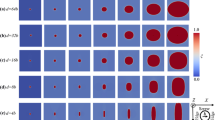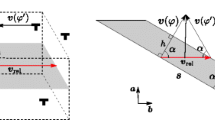Abstract
The equilibrium configurations of a row of uniformly distributed dislocation dipoles are first studied. The analysis is then generalised to study dipoles in two-dimensional rectangular periodic lattices. By examining the stability of the equilibrium configurations we find that the system may undergo a natural transition from the Taylor lattice to a row of dipole walls. This bifurcation may be involved in the transition from channel-vein to persistent slip band (PSB) structures in the early stage of metal fatigue.











Similar content being viewed by others
References
Ahmed, J., Wilkinson, A.J., Roberts, S.G.: Electron channelling contrast imaging characterization of dislocation structures associated with extrusion and intrusion systems and fatigue cracks in copper single crystals. Philos. Mag., A, Phys. Condens. Matter Struct. Defects Mech. Prop. 81(6), 1473–1488 (2001)
Amodeo, R.J., Ghoniem, N.M.: Dislocation dynamics. 2. Applications to the formation of persistent slip bands, planar arrays and dislocation cells. Phys. Rev. B 41(10), 6968–6976 (1990)
Basinski, Z.S., Basinski, S.J.: Fundamental-aspects of low amplitude cyclic deformation in face-centered cubic-crystals. Prog. Mater. Sci. 36, 89–148 (1992)
Cai, W., Bulatov, V.V., Chang, J.P., Li, J., Yip, S.: Anisotropic elastic interactions of a periodic dislocation array. Phys. Rev. Lett. 86(25), 5727–5730 (2001)
Cash, W.D., Cai, W.: Contribution of dislocation dipole structures to the acoustic nonlinearity. J. Appl. Phys. 111(074906), 1–8 (2012)
Cottrell, A.H.: Dislocations and Plastic Flow in Crystals. Clarendon Press, Oxford (1953)
Hirth, J.P., Lothe, J.: Theories of Dislocations. Krieger, Melbourne (1982)
Laird, C., Charsley, P., Mughrabi, H.: Low-energy dislocation-structures produced by cyclic deformation. Mater. Sci. Eng. 81(1–2), 433–450 (1986)
Lubarda, V.A., Kouris, D.A.: Stress fields due to dislocation walls in infinite and semi-infinite bodies. Mech. Mater. 23(3), 169–189 (1996)
Mughrabi, H.: Microscopic mechanisms of metal fatigue. In: Proc. 5th Int. Conf. on the Strength of Metals and Alloys, vol. 3, pp. 1615–1638. Pergamon, Oxford (1980)
Nabarro, F.R.N.: The mathematical theory of stationary dislocations. Adv. Phys. 1(3), 269 (1952)
Neumann, P.: Low-energy dislocation configurations—a possible key to the understanding of fatigue. Mater. Sci. Eng. 81(1–2), 465–475 (1986)
Taylor, G.I.: The formation of emulsions in definable fields of flow. Proc. R. Soc. Lond. Ser. A, Math. Phys. Sci. 146, 501–523 (1934)
Taylor, G.I.: The mechanism of plastic deformation of crystals. Part I. Theoretical. Proc. R. Soc. Lond. A 145, 362–384 (1934)
Zhu, X.H., Dai, S.Y., Xiang, Y.: Numerical simulation of dynamics of dislocation arrays and long-range stress fields of nonplanar dislocation arrays. Int. J. Plast. 43, 85–100 (2013)
Zhu, Y.: Modelling the transition from channel-veins to psbs in the early stage of fatigue tests. Ph.D. thesis, University of Oxford (2012)
Zhu, Y., Chapman, S.J.: Motion of screw segments in the early stage of fatigue testing. Mater. Sci. Eng. A, Struct. Mater.: Prop. Microstruct. Process. 589(1), 132–139 (2014)
Acknowledgements
YZ is supported by EPSRC grant EP/D048400/1.
Author information
Authors and Affiliations
Corresponding author
Rights and permissions
About this article
Cite this article
Zhu, Y., Chapman, S.J. A Natural Transition Between Equilibrium Patterns of Dislocation Dipoles. J Elast 117, 51–61 (2014). https://doi.org/10.1007/s10659-013-9464-z
Received:
Published:
Issue Date:
DOI: https://doi.org/10.1007/s10659-013-9464-z




